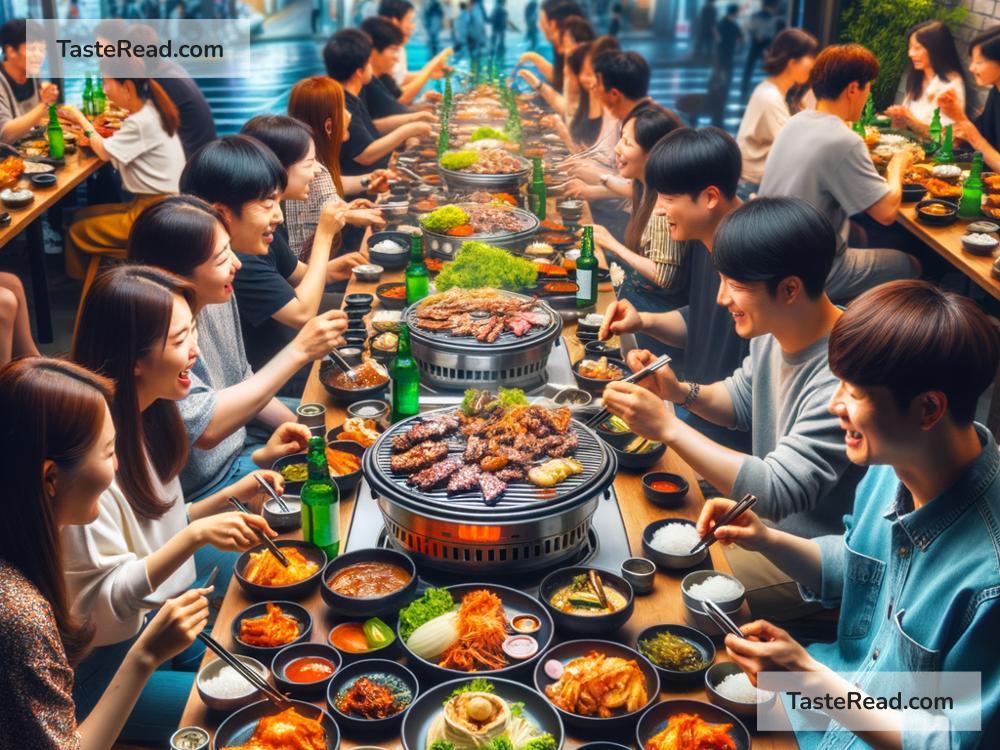Journeying Through Spicy Korean BBQ Rituals in Seoul, South Korea
Imagine yourself in the bustling heart of Seoul, South Korea, with lights sparkling and people chatting in lively streets. In this vibrant city, there’s no shortage of exciting food to explore, but one dish stands out for its unforgettable flavors and social experience: Korean BBQ. Whether you’re visiting South Korea for the first time or are a seasoned traveler, trying spicy Korean BBQ is an essential stop on your culinary journey.
What Makes Korean BBQ Special?
Korean BBQ isn’t just a meal; it’s an interactive ritual. Unlike other cuisines where food is served fully cooked, Korean BBQ invites you to be part of the cooking process. At Korean BBQ restaurants, the table becomes your kitchen. In the middle of the table, there’s usually a built-in grill where meat is cooked right in front of you—or even by you if you want to give it a try.
But it’s not just about grilling. Korean BBQ is a feast for your taste buds, combining smoky, spicy, and sweet flavors all in one bite. The spicy variety, often marinated in chili paste or pepper sauces, carries enough heat to make you appreciate every mouthful while keeping you coming back for more.
The Atmosphere and Setting
Walking into a Korean BBQ restaurant in Seoul is an experience in itself. The air is often filled with the mouthwatering smell of sizzling meats. You’ll hear laughter and chatter from groups of friends, couples, or families gathered around tables enjoying good food and meaningful conversations. Korean BBQ isn’t something you eat alone; it’s a social event meant to be shared with others.
The seating arrangements are usually cozy, encouraging close interactions. The waiters are attentive yet give you the freedom to cook and serve your meal your way. If you’re unsure how to grill or eat your food, don’t worry—the staff is always happy to help. Locals also take pride in teaching visitors about the tradition.
The Ingredients: A Symphony of Flavors
Spicy Korean BBQ brings together fresh ingredients and unique sauces that make every bite exciting. Common types of meat include pork belly (samgyeopsal), beef ribs (galbi), and chicken. The spicy varieties often come coated in gochujang, a rich and fiery red chili paste that serves as the backbone of many Korean dishes. Gochujang, combined with garlic, sesame oil, and other spices, creates a marinade that works magic on the meat.
But Korean BBQ isn’t just about the meat—it’s about the whole experience. Accompanying the star of the show are several side dishes known as banchan, which include items like kimchi (fermented spicy cabbage), pickled radish, and seasoned spinach. These small plates are placed around the grill, adding depth and variety to your meal. You’re encouraged to mix and match sides with your BBQ for a perfect balance of flavors.
The Cooking Process: A Hands-On Adventure
When your plate of raw, marinated meat arrives at the table, the fun begins. Place the meat on the hot grill and watch as it sizzles and caramelizes. The aroma of spices fills the air as the meat starts to brown, creating excitement for the meal ahead.
While grilling, some locals might tell you that timing is everything. Too much time on the grill can overcook the meat, while too little can leave it underdone. The goal is to achieve the perfect char that locks in the flavors and gives the meat a slightly smoky taste.
To eat Korean BBQ like a local, wrap a piece of grilled meat in a lettuce leaf along with rice, kimchi, raw garlic slices, and a dab of ssamjang (a thick, savory dipping sauce). Fold it into a neat little package and pop it into your mouth for an explosion of flavors.
Spice Levels: How Hot Can You Handle?
Spicy Korean BBQ is not for the faint-hearted, although you can adjust the spice level to suit your preference. For those who enjoy fiery flavors, restaurants often offer extra chili sauces or spicier marinades. If you’re not used to spicy food, go for milder options or balance the heat with cooling sides like cucumber slices or pickled radish.
Regardless of your spice tolerance, the beauty of Korean BBQ is that it caters to everyone. You can mix and match spicy and non-spicy options to create a meal that suits your mood.
More Than Just Food: A Cultural Experience
In Seoul, eating Korean BBQ is more than just enjoying delicious food—it’s a cultural experience. For Koreans, meals are a time to connect with loved ones and celebrate togetherness, and BBQ creates the perfect setting for this. Sharing meat from the same grill, passing around side dishes, and laughing over spicy bites brings people closer.
For tourists, trying Korean BBQ offers a chance to engage in a tradition deeply rooted in Korean culture. It’s not just about the food, but also about learning how locals eat, interact, and bond over meals.
Tips for First-Timers
If you’re new to Korean BBQ, here are some tips to make the most of your experience:
- Go with friends or family: Korean BBQ is best enjoyed with a group—it’s the perfect social meal.
- Ask for recommendations: Don’t hesitate to ask the staff if you’re unsure which meats or sauces to try.
- Try different combinations: Don’t limit yourself—mix and match side dishes and dipping sauces to find your favorite flavors.
- Take your time: Korean BBQ isn’t a rushed meal. Enjoy the process of grilling and eating slowly.
Conclusion
Journeying through spicy Korean BBQ rituals in Seoul is an unforgettable adventure for your taste buds and your soul. It’s a celebration of food, friendship, and culture that leaves you with lasting memories. The next time you find yourself in South Korea, be sure to gather around a grill, dive into the world of spicy flavors, and enjoy the warmth and community that Korean BBQ brings. It’s not just a meal—it’s an experience you’ll treasure forever.


